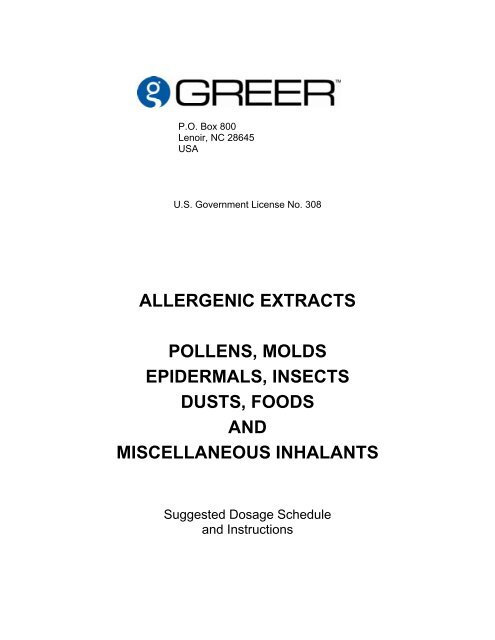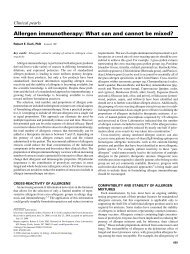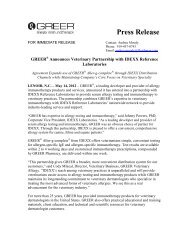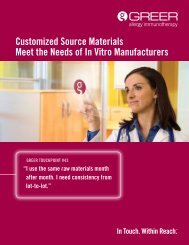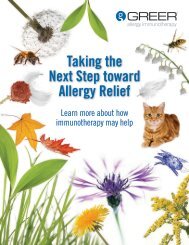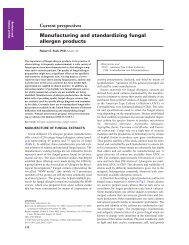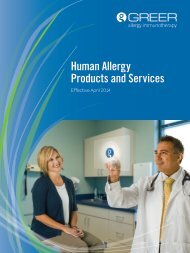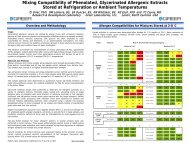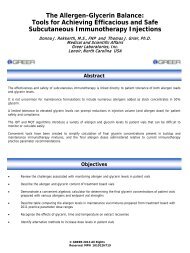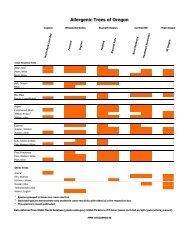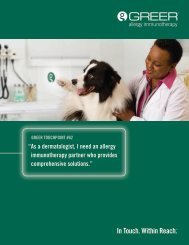allergenic extracts pollens, molds epidermals, insects dusts ... - Greer
allergenic extracts pollens, molds epidermals, insects dusts ... - Greer
allergenic extracts pollens, molds epidermals, insects dusts ... - Greer
Create successful ePaper yourself
Turn your PDF publications into a flip-book with our unique Google optimized e-Paper software.
P.O. Box 800<br />
Lenoir, NC 28645<br />
USA<br />
U.S. Government License No. 308<br />
ALLERGENIC EXTRACTS<br />
POLLENS, MOLDS<br />
EPIDERMALS, INSECTS<br />
DUSTS, FOODS<br />
AND<br />
MISCELLANEOUS INHALANTS<br />
Suggested Dosage Schedule<br />
and Instructions
WARNING<br />
THIS ALLERGENIC PRODUCT IS INTENDED FOR USE BY PHYSICIANS WHO<br />
ARE EXPERIENCED IN THE ADMINISTRATION OF ALLERGENIC EXTRACTS AND<br />
THE EMERGENCY CARE OF ANAPHYLAXIS, OR FOR USE UNDER THE<br />
GUIDANCE OF AN ALLERGY SPECIALIST.<br />
ALLERGENIC EXTRACTS MAY CAUSE SEVERE OR FATAL ANAPHYLAXIS IN<br />
EXTREMELY SENSITIVE PATIENTS. THE INITIAL DOSE MUST BE BASED ON<br />
SKIN TESTING AS DESCRIBED IN THE DOSAGE AND ADMINISTRATION SECTION<br />
OF THIS INSERT. PATIENTS SHOULD BE INSTRUCTED TO RECOGNIZE<br />
ADVERSE REACTION SYMPTOMS AND CAUTIONED TO CONTACT THE<br />
PHYSICIAN'S OFFICE IF REACTION SYMPTOMS OCCUR. IN CERTAIN<br />
INDIVIDUALS, THESE REACTIONS COULD BE FATAL. PATIENTS SHOULD BE<br />
OBSERVED FOR AT LEAST 20 MINUTES FOLLOWING TREATMENT.<br />
EMERGENCY MEASURES, AS WELL AS PERSONNEL TRAINED IN THEIR USE,<br />
SHOULD BE IMMEDIATELY AVAILABLE IN THE EVENT OF A LIFE- THREATENING<br />
REACTION. PATIENTS BEING SWITCHED FROM ONE LOT OF EXTRACT TO<br />
ANOTHER FROM THE SAME MANUFACTURER SHOULD HAVE THEIR DOSE<br />
REDUCED BY 75%.<br />
THIS PRODUCT SHOULD NOT BE INJECTED INTRAVENOUSLY.<br />
REFER ALSO TO THE WARNINGS, PRECAUTIONS, ADVERSE REACTIONS<br />
AND OVERDOSAGE SECTION BELOW.<br />
DESCRIPTION<br />
Allergenic Extracts are supplied as a sterile solution for intracutaneous or<br />
subcutaneous administration. Concentrates contain the soluble extractants of the<br />
source material with 0.5% sodium chloride and 0.54% sodium bicarbonate at a pH of<br />
6.8 to 8.4 as aqueous <strong>extracts</strong> in water for injection or in 50% glycerin. Aqueous<br />
<strong>extracts</strong> contain 0.4% phenol as a preservative and 50% glycerinated <strong>extracts</strong> contain<br />
0.2% phenol. Diluted aqueous <strong>extracts</strong> contain Buffered Saline with 0.5% sodium<br />
chloride, 0.04% potassium phosphate, 0.11% sodium phosphate heptahydrate, and<br />
0.4% phenol in water for injection.<br />
Source materials for these <strong>extracts</strong> are as follows: Pollens are collected from the<br />
respective grasses, weeds, trees, shrubs, cultured plants and flowers. Mold <strong>extracts</strong><br />
are produced from pure culture mycelial mats. Rusts and smuts are obtained from<br />
natural growths. Epidermal <strong>extracts</strong> are produced from the hide, hair, or feathers<br />
containing the natural dander, or from separated dander. Insects are the whole body<br />
<strong>insects</strong>. House dust is made from various <strong>dusts</strong> ordinarily found in the home with the<br />
extract dialyzed to remove low-molecular weight irritants and concentrated to an<br />
extraction ratio of 1:1. Food <strong>extracts</strong> are prepared from the edible portions of the<br />
respective foods, obtained fresh if possible. Certain diagnostic food <strong>extracts</strong> contain<br />
0.1% sodium formaldehyde sulfoxylate as an antioxidant. Other miscellaneous<br />
inhalants involved in respiratory allergy are obtained in the naturally occurring form to<br />
which a patient may be exposed.
Extracts are labeled either by weight-to-volume (w/v) based on the weight of the<br />
source material to the volume of the extracting fluid, or in protein nitrogen units (PNU)<br />
based on assay with one PNU representing 0.00001 mg of protein nitrogen.<br />
CLINICAL PHARMACOLOGY<br />
The allergic reaction is dependent upon the presence of antigen-specific<br />
immunoglobulin E (IgE) antibodies that are bound to specific receptors on mast cells<br />
and basophils. The presence of IgE antibodies on mast cells and basophils sensitizes<br />
these cells and, upon interaction with the appropriate allergen, histamine and other<br />
mediators are released. IgE antibody has been shown to correlate with atopic diseases<br />
such as allergic rhinitis and allergic asthma. (1-4) In the skin these mediators are<br />
responsible for the characteristic wheal and flare (erythema) reactions upon Allergenic<br />
Extract skin testing in persons with the specific allergies. (3-7)<br />
Specific immunotherapy with Allergenic Extracts as employed for over 45 years is<br />
helpful in reducing symptoms associated with exposure to the offending allergens. A<br />
summary of effectiveness by the Panel on Review of Allergenic Extracts, an advisory<br />
committee to the U.S. Food and Drug Administration, has been published. (8) Several<br />
mechanisms have been proposed to explain the effectiveness of immunotherapy: an<br />
increase in antigen-specific IgG antibodies is frequently associated with clinical<br />
effectiveness, although correlation is not consistent in all studies; there is a decrease in<br />
specific IgE; and IgE production is suppressed during periods of seasonal or high<br />
exposure to the antigen. (9) Other changes following immunotherapy have been noted<br />
including development of auto-anti-idiotypic antibodies; a decrease in blood basophil<br />
sensitivity to allergen; a decrease in lymphokine production and lymphocyte proliferation<br />
by cells exposed to allergen; and development of allergen-specific suppressor cells. (10)<br />
The complete mechanisms of immunotherapy are not known and remain the subject of<br />
investigation.<br />
INDICATIONS AND USAGE<br />
Allergenic Extracts are indicated for the diagnosis and treatment of patients with<br />
immediate hypersensitivity allergy to the respective allergens, inhaled, ingested or<br />
otherwise introduced into contact with sensitive tissues. The diagnosis of IgE-mediated<br />
allergy may be established by the allergy history, clinical evaluation, and skin test<br />
reactivity. (4,7,11) Immunotherapy with Allergenic Extracts is indicated when testing and<br />
patient history have identified the offending allergens and when it is not possible or<br />
practical to avoid these allergens. (12-14) Food <strong>extracts</strong> have not been proven effective in<br />
immunotherapy.<br />
The use of Allergenic Extracts for the above purposes should be made only by<br />
physicians with special familiarity and knowledge of allergy. (See DOSAGE AND<br />
ADMINISTRATION)<br />
CONTRAINDICATIONS<br />
There are no known absolute contraindications to the use of Allergenic Extracts for<br />
immunotherapy. Immunotherapy with specific antigens should not be done in those<br />
individuals who do not exhibit skin test or clinical sensitivity to the particular antigens.<br />
(See below under WARNINGS and PRECAUTIONS)
Allergenic extract injections should not be administered in the presence of diseases<br />
characterized by a bleeding diathesis.<br />
Children with nephrotic syndrome require careful consideration and probably should<br />
not receive injection therapy because a variety of seemingly unrelated events, such as<br />
immunization, can cause an exacerbation of their nephrotic disease.<br />
General contraindications include:<br />
EXTREME SENSITIVITY TO THE SPECIFIC ALLERGEN - Determined from<br />
previous anaphylaxis following exposure.<br />
AUTOIMMUNE DISEASE - Individuals with autoimmune disease may be at risk, due<br />
to the possibility of routine immunizations exacerbating symptoms of the underlying<br />
disease.<br />
WARNINGS<br />
Concentrated <strong>extracts</strong> must be diluted with a sterile diluent prior to first use on a<br />
patient for treatment or intradermal testing. Allergenic Extracts are manufactured to<br />
assure high potency and have the ability during skin testing and immunotherapy to<br />
cause serious local and systemic reactions including death in sensitive patients. Most<br />
reactions occur within 20 minutes after injection, (15) but may occur later. (16) To minimize<br />
the potential for local or systemic reactions, the relative sensitivity of the patient must be<br />
assessed from the allergic history and from clinical observations. Patients should be<br />
informed of these risks prior to skin testing and immunotherapy (see PRECAUTIONS<br />
and ADVERSE REACTIONS below).<br />
Allergenic Extract immunotherapy doses should be lowered or temporarily withheld<br />
from patients if any of the following conditions exist:<br />
(1) severe symptoms of rhinitis and/or asthma<br />
(2) infection or flu accompanied by fever<br />
(3) exposure to excessive amounts of clinically relevant allergen prior to a scheduled<br />
injection<br />
(4) evidence of a local or systemic reaction to the preceding extract injection during<br />
a course of immunotherapy<br />
The dosage must be reduced when modifying dosages or components in a mixture<br />
or an individual prescription, or when starting a patient on fresh extract, even though the<br />
labeled strength of the old and new vials may be the same. This reduction in dosage<br />
may be necessary due to the older vial losing potency during storage, or due to different<br />
sensitivities to different components. The amount of new extract given should not<br />
exceed 25% of the last dose given from the old vial, assuming both <strong>extracts</strong> contain<br />
comparable amounts of allergen. Any evidence of a local or generalized reaction<br />
requires a reduction in dosage during the initial stages of immunotherapy, as well as<br />
during maintenance therapy.<br />
PRECAUTIONS<br />
GENERAL:<br />
Not for intravenous use!<br />
Systemic allergic reactions may occur as a result of immunotherapy. The risk can be<br />
minimized by adherence to a careful injection schedule, which starts with a low<br />
concentration of extract and is increased slowly. Because of the danger of serious
eactions, caution is needed in testing exquisitely sensitive patients, particularly with<br />
potent allergens, e.g., peanut, cottonseed, and flaxseed. (8) Such <strong>extracts</strong> should be<br />
appropriately diluted before use.<br />
The physician must be prepared to treat anaphylaxis should it occur and have the<br />
necessary drugs and equipment on hand to do so. (17-18) Extracts should not be<br />
administered by the patient or other individuals who are not prepared to treat<br />
anaphylaxis should it occur.<br />
Patients receiving Allergenic Extracts should be kept under observation a minimum<br />
of twenty (20) minutes so that any adverse reaction can be observed and properly<br />
handled. (15) This time should be extended for high-risk patients such as those with<br />
unstable asthma or those suffering an exacerbation of their symptoms.<br />
Patients receiving beta blockers may not be responsive to beta adrenergic drugs<br />
used to treat anaphylaxis. The risks of anaphylaxis in these patients should be carefully<br />
weighed against the benefits of immunotherapy.<br />
Check the lot number and dosage schedule of the patient to verify correctness of a<br />
prescription number, a vial number, or strength. Only after this verification has been<br />
made should an injection be given.<br />
A separate sterile needle and syringe should be used for each patient to prevent<br />
transmission of hepatitis or other infectious agents.<br />
INFORMATION FOR PATIENTS:<br />
Most serious reactions following the administration of Allergenic Extracts occur<br />
within 20 minutes; the patient should remain under observation for this period of time or<br />
longer if instructed by the physician. The size of any local reaction should be recorded,<br />
because increasingly large local reactions may precede a subsequent systemic reaction<br />
with increasing dosage. The patient should be instructed to report any unusual<br />
reactions. In particular, this includes unusual swelling and/or tenderness at the injection<br />
site, or reactions such as rhinorrhea, sneezing, coughing, wheezing, shortness of<br />
breath, nausea, dizziness, or faintness. Reactions may occur some time after leaving<br />
the physician's office, in which case medical attention should be sought immediately.<br />
DRUG INTERACTIONS: Skin test diagnosis with Allergenic Extracts is contraindicated<br />
within 24 hours after the last dose of most antihistamines, within 48 hours after the last<br />
dose of terfenadine, and within 3 weeks or longer after the last dose of astemizole.<br />
These products suppress histamine skin test reactions and could mask a positive<br />
response.<br />
CARCINOGENESIS, MUTAGENESIS, IMPAIRMENT OF FERTILITY: There is no<br />
evidence of carcinogenicity, mutagenesis or impairment of fertility in humans from<br />
Allergenic Extracts. No long-term studies in animals have been performed to evaluate<br />
carcinogenic potential.<br />
PREGNANCY: PREGNANCY CATEGORY C - Animal reproduction studies have not<br />
been conducted with Allergenic Extracts. It is also not known whether Allergenic<br />
Extracts can cause fetal harm when administered to a pregnant woman or whether they<br />
can affect reproduction capacity. Allergenic Extracts should be given to a pregnant<br />
woman only if clearly needed.
There is no evidence of adverse effects of Allergenic Extracts on the fetus. (8)<br />
Studies have not been performed in animals to determine whether <strong>extracts</strong> affect fertility<br />
in males or females, have teratogenic potential, or have other adverse effects on the<br />
fetus. Caution should be exercised in testing or treating pregnant females because a<br />
systemic reaction may cause an abortion as a result of uterine muscle contractions.<br />
LABOR AND DELIVERY: There is no known information of adverse effects during<br />
labor and delivery.<br />
NURSING MOTHERS: It is not known whether this product is excreted in human milk.<br />
Because many drugs are excreted in human milk, caution should be exercised when<br />
<strong>extracts</strong> are administered to a nursing woman.<br />
PEDIATRIC AND GERIATRIC USE: Although most <strong>extracts</strong> have not been studied<br />
systematically in children, children and geriatric patients appear to tolerate injections of<br />
Allergenic Extracts well. Studies with pollenosis and asthma have been conducted in<br />
children (e.g. refs. 19-21) . Extract usage in children should follow the same precautions as in<br />
adults.<br />
ADVERSE REACTIONS<br />
Adverse systemic reactions may occur within minutes upon use of an Allergenic<br />
Extract to which a person has specific sensitivity. These reactions consist primarily of<br />
allergic symptoms such as generalized skin erythema, urticaria, pruritus, angioedema,<br />
rhinitis, wheezing, laryngeal edema, and hypotension. Less commonly, nausea,<br />
emesis, abdominal cramps, diarrhea and uterine contractions may occur. Severe<br />
reactions may cause shock and loss of consciousness. Fatalities have occurred<br />
rarely. (8,22,23) These systemic reactions occur with varying frequency in different clinics<br />
and are usually less than 1%. To some extent, the reaction rate is related to the type<br />
and dose of administered extract and to the sensitivity of the patient. In general,<br />
immunotherapy with Allergenic Extracts is considered to be safe. (24) Despite all<br />
precautions, occasional reactions are unavoidable.<br />
Adverse systemic reactions should be treated as follows:<br />
A. A tourniquet should be immediately applied to the extremity above the site of<br />
injection. Release the tourniquet every few minutes for a few seconds.<br />
B. Epinephrine 1:1000 should be injected immediately in the opposite arm in amounts<br />
of 0.3 to 0.5 mL and 0.2 mL epinephrine should be administered at the site of injection.<br />
For children below the age of 6 years, adjust the dosage of epinephrine to 0.005 mL per<br />
pound of body weight per dose. Repeat epinephrine dosage in 15 minutes if necessary<br />
and if symptoms persist.<br />
C. Adverse reactions not responding to epinephrine therapy may require the use of<br />
parenteral bronchodilators, vasopressors, oxygen, or volume replacement therapy.<br />
Local reactions consisting of erythema, itching, swelling, tenderness and sometimes<br />
pain may occur at the injection site. These reactions may appear within a few minutes<br />
to hours and persist for several days. Local cold applications and oral antihistamines<br />
may be effective treatment. For marked and prolonged local reactions, steroids may be<br />
helpful.
OVERDOSAGE<br />
Systemic reactions are uncommon after injection, but if the patient receives more<br />
extract than can be tolerated at that particular time and begins to experience immediate<br />
hypersensitivity anaphylaxis, the procedures listed under ADVERSE REACTIONS<br />
should be instituted.<br />
Overdosage may occur because of an error in the volume of extract injected, or an<br />
incorrect dilution injected, or because the patient may be exposed to airborne or<br />
environmental antigens simultaneously with injection of the same antigens. In the event<br />
of a systemic reaction occurring, the dosage schedule should be carefully adjusted as<br />
outlined above under WARNINGS.<br />
DOSAGE AND ADMINISTRATION<br />
1. DIAGNOSTIC TESTING<br />
For the patient with a suspected diagnosis of allergy to more than one antigen, initial<br />
skin testing should include the individual <strong>extracts</strong>. If a screening skin test with a mixture<br />
is used, a positive response should be followed by testing with the individual <strong>extracts</strong> to<br />
determine the degree of sensitivity to each and to guide in the selection of <strong>extracts</strong> and<br />
their concentration for immunotherapy if indicated. However, because a negative skin<br />
test with a mixture may not be indicative of the absence of allergy to one or more of the<br />
components due to their dilution, testing with individual <strong>extracts</strong> is more precise. False<br />
negative responses may occur if serum levels of antihistamines remain from prior<br />
medication administration (see CONTRAINDICATIONS). The use of a positive control<br />
is especially recommended for patients on prior medications which may decrease the<br />
histamine skin test response.<br />
Scratch or Prick-puncture Skin Testing:<br />
Allergenic Extract concentrates may be used for scratch or prick-puncture testing or<br />
scratch tests in 50% glycerin, 1:20 w/v or strongest available strength in 5 mL vials may<br />
be used. Prick-puncture tests with concentrated <strong>extracts</strong> in patients highly sensitive to<br />
the specific antigen should yield distinctive wheals with diameters of greater than 5 mm<br />
and with much larger erythema reactions. Glycerinated histamine phosphate 5 mg/mL<br />
(1.8 mg/mL histamine base) or aqueous histamine phosphate 2.75 mg/mL (1 mg/mL<br />
histamine base; 1:1,000 W/V) may be used as a positive control.<br />
Intradermal Skin Testing:<br />
Extract for intradermal testing must be prepared by diluting the stock concentrate<br />
injection vials with sterile diluent (use normal or buffered saline, or normal saline with<br />
human serum albumin) or the appropriate dilutions may be purchased.<br />
a. Patients with a negative scratch or prick-puncture test:<br />
Patients who do not react to a scratch or prick-puncture test should be tested<br />
intradermally, using a 26 or 27 gauge 1/4 inch needle, with 0.02 to 0.05 mL of an<br />
appropriate extract dilution from 1/100 to 1/1000 of the concentrate. A negative test<br />
should be followed by a repeat test using a higher concentration until significant wheal<br />
and flare reaction sizes are attained or until the responses remain negative. As a<br />
negative control use the diluent or, in the case of <strong>extracts</strong> in 50% glycerin, use 0.5% to
1% glycerosaline solution. As a positive control, use glycerinated histamine phosphate<br />
diluted to 0.5 mg/mL (0.18 mg/mL histamine base) or aqueous histamine phosphate<br />
0.275 mg/mL (0.1 mg/mL histamine base).<br />
b. Patients tested only by the intradermal method:<br />
Since highly reactive individuals may react intracutaneously at 1:1 million or even<br />
1:10 million dilutions, any intradermal injection should be preceded by a puncture test<br />
and the dose adjusted accordingly. Other patients suspected of being moderately<br />
allergic should be tested with 0.02 to 0.05 mL of an appropriate extract dilution on the<br />
order of 1/10,000 to 1/100,000 of the concentrate. A negative test should be followed<br />
by repeat tests using progressively stronger ten-fold concentrations until significant<br />
wheal and flare reaction sizes are attained, or until skin test responses with the higher<br />
concentrations remain negative. As a negative control, use the diluent or, in the case of<br />
<strong>extracts</strong> in 50% glycerin, use 0.5% to 1% glycerosaline solution. As a positive control,<br />
use glycerinated histamine phosphate diluted to 0.5 mg/mL (0.18 mg/mL histamine<br />
base) or aqueous histamine phosphate 0.275 mg/mL (0.1 mg/mL histamine base).<br />
Skin tests are graded in terms of the wheal and erythema response noted at 15 to<br />
20 minutes, and compared to the appropriate controls. Wheal and erythema sizes may<br />
be recorded by actual measurement.<br />
2. IMMUNOTHERAPY<br />
Immunotherapy is administered by subcutaneous injection. Dosage of Allergenic<br />
Extracts is individualized according to the patient's sensitivity, the clinical response, and<br />
tolerance to the extract administered during the phases of an injection regimen. The<br />
initial dose of the extract should be determined based on the puncture test reactivity. In<br />
patients who appear to be exquisitely sensitive by history and skin test, the initial dose<br />
of the extract should be 0.05 to 0.1 mL of a low concentration, such as dilution number<br />
5 or 6 in below. Patients with lesser sensitivity may be started with 0.05 to 0.1 mL of the<br />
next higher concentration. The amount of Allergenic Extract is increased at each<br />
injection by no more than 50% of the previous amount, and the next increment is<br />
governed by the response to the last injection. Large local reactions which persist for<br />
longer than 24 hours are generally considered an indication for repeating the previous<br />
dose or reducing the dose at the next administration. Any evidence of systemic reaction<br />
is an indication for a reduction of 75% in the subsequent dose. The upper limits of<br />
dosage have not been established; however, doses larger than 0.2 mL of an extract in<br />
50% glycerin may cause discomfort upon injection. The dosage of Allergenic Extract<br />
does not vary significantly with the allergic disease under treatment.<br />
To prepare dilutions starting from a concentrate such as 1:10 W/V, 1:20 W/V, OR<br />
20,000 PNU/mL, proceed as in Table 1 below. (Note: Add 0.5 mL of concentrate to<br />
4.5 mL of sterile diluent and make additional dilutions in the same manner.)
TABLE 1<br />
Ten-Fold Dilution Series*<br />
Dilution Extract Diluent W/V W/V PNU/mL<br />
0 Concentrate 1:10 1:20 20,000<br />
1 0.5 mL concentrate 4.5 mL 1:100 1:200 2,000<br />
2 0.5 mL dilution 1 4.5 mL 1:1,000 1:2,000 200<br />
3 0.5 mL dilution 2 4.5 mL 1:10,000 1:20,000 20<br />
4 0.5 mL dilution 3 4.5 mL 1:100,000 1:200,000 2<br />
5 0.5 mL dilution 4 4.5 mL 1:1,000,000 1:2,000,000 0.2<br />
6 0.5 mL dilution 5 4.5 mL 1:10,000,000 1:20,000,000 0.02<br />
*There is no direct potency correlation across the table between PNUs and W/V.<br />
The optimal interval between doses of Allergenic Extract has not been established.<br />
Injections usually are given 1 or 2 times per week until the maintenance dose is<br />
reached. The injection interval then is increased to 2 weeks, then to 3 weeks, and<br />
finally to 4 weeks. If the patient does not return for 6 to 8 weeks, the dose should be<br />
reduced to 25% of the last dose. If longer than 8 weeks, a dose reduction of one, two or<br />
three dilutions may be made considering the components and the patient's sensitivity.<br />
The dosage and the interval between injections may need to be modified according to<br />
the clinical response of the patient. When switching patients to fresh extract, the initial<br />
dose should be reduced to 25% of the previous dose.<br />
The usual duration of treatment has not been established. A period of two or three<br />
years of injection therapy constitutes an average minimum course of treatment.<br />
HOW SUPPLIED<br />
Stock concentrate <strong>extracts</strong> containing up to 40,000 PNU/mL, or 1:10 W/V or other<br />
dilutions as requested by the physician are supplied in 5, 10, 30 and 50 mL in aqueous<br />
or 50% glycerin buffered saline. House dust extract is supplied in a 1:1 W/V<br />
concentrate, or a maximum of 10,000 PNU/mL. Extracts are also supplied in dropper<br />
vials for scratch or prick testing.<br />
STORAGE<br />
Allergenic Extracts should be stored at 2-8°C and kept at this temperature range<br />
during office use. Refer to vial labels for expiration dates. Diluted <strong>extracts</strong> are<br />
inherently less stable than concentrates. Dilutions of glycerinated <strong>extracts</strong> which result<br />
in glycerin below 50% are also less stable. The more dilute <strong>extracts</strong> in aqueous diluents<br />
should be replenished daily. Potency of a particular dilution can be checked by skin test<br />
in comparison to a fresh dilution of the extract on an individual known to be allergic to<br />
the specific antigen.
REFERENCES<br />
1. Lichtenstein LM, Ishizaka K, Norman PS, et al. IgE antibody measurements in<br />
ragweed hayfever: relationship to clinical severity and the results of immunotherapy.<br />
J Clin Invest 1973;52:474.<br />
2. Elgefors B, Julin A, Johansson SGO. Immunoglobulin E in bronchial asthma. Acta<br />
Allergol 1974;29:327.<br />
3. Norman PS. The clinical significance of IgE. Hosp Pract 1975;10:41-49.<br />
4. Bryant DA, Burns MW, Lazarus L. The correlation between skin tests, bronchial<br />
provocation tests and the serum level of IgE specific for common allergens in<br />
patients with asthma. Clin Allergy 1975;5:145.<br />
5. Loeffler JA, Cawley LP, Moeder M. Serum IgE levels: correlation with skin test<br />
sensitivity. Ann Allergy 1973;31:331.<br />
6. Pepys J. Skin tests in diagnosis. In Gell PGH, Coombs RRA, Lachman PJ, eds.<br />
Clinical aspects of Immunology. Oxford: Blackwell Scientific Publications, 1975.<br />
7. Burrows B, et al. Respiratory disorders and allergy skin test reactions. Ann Allergy<br />
1976;84:134.<br />
8. Implementation of Efficacy Review, Allergenic Extracts. Federal Register<br />
1985;50:3082-3288<br />
9. Levy DA, Lichenstein LM, Goldstein EO, Ishizaka K. Immunologic and cellular<br />
changes accompanying the therapy of pollen allergy. J Clin Invest 1973;50:360.<br />
10. Gurka G, Rocklin R. Immunologic responses during allergen-specific<br />
immunotherapy for respiratory allergy. Ann Allergy 1988;61:239-43.<br />
11. Zeiss CR Jr. Patient evaluation. In: Allergy and Clinical Immunology, Locky RF, ed.<br />
Garden City, N.Y.: Medical Examination Publishing 1976:616.<br />
12. Frankland AW, Augustin R. Prophylaxis of summer hay-fever and asthma: a<br />
controlled trial comparing crude grass-pollen <strong>extracts</strong> with the isolated main protein<br />
component. Lancet 1954;1:1055.<br />
13. Frankland AW, Augustin R. Grass pollen antigens effective in treatment. Clin Sci<br />
1962;23:95.<br />
14. Rohr AS, Marshall NA, Saxon A: Successful immunotherapy for Triatoma<br />
protracta-induced anaphylaxis. J Allergy Clin Immunol 1984;73:369-75.<br />
15. Executive Committee, American Academy of Allergy and Immunology. The waiting<br />
period after allergen skin testing and immunotherapy (Position statement). J Allergy<br />
Clin Immunol 1990;85:526-7.<br />
16. Greenberg MA, Kaufman CR, Gonzalez GE, Rosenblatt CD, Smith LJ,<br />
Summers RJ. Late and immediate systemic-allergic reactions to inhalant allergen<br />
immunotherapy. J Allergy Clin Immunol 1986;77:865-70.<br />
17. Ouellette JJ. Emergency management of the allergic reactions. Modern Medicine<br />
1975;99.<br />
18. Anderson JA, et al. Personnel and equipment to treat systemic reactions caused by<br />
immunotherapy with <strong>allergenic</strong> <strong>extracts</strong>. J Allergy Clin Immunol 1986;77:271-3.<br />
19. Sadan N, Rhyne MB, Mellits ED, et al. Immunotherapy of pollenosis in children:<br />
investigation of the immunologic basis of clinical improvement. N Eng J Med<br />
1969;280:623.<br />
20. Johnstone DE. Value of hyposensitization therapy for perennial bronchial asthma in<br />
children. Pediatrics 1961;27:39.
21. VanAsperin PP, Kemp AS, Mellis CM. Skin test reactivity and clinical allergen<br />
sensitivity in infancy. J Allergy Clin Immunol 1984;73:381-6.<br />
22. Committee on Safety of Medicine. Desensitizing vaccines. Br Med J 1986;293:948.<br />
23. Lockey RF, Benedict LM, Turkeltaub PC, Bukantz SC. Fatalities from<br />
immunotherapy (IT) and skin testing (ST). J Allergy Clin Immunol 1987;79:660-77.<br />
24. Norman PS, Van Metre TE Jr. The safety of <strong>allergenic</strong> immunotherapy. J Allergy<br />
Clin Immunol 1990;85:522-5.<br />
L-502<br />
Revised 4/04


